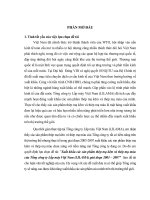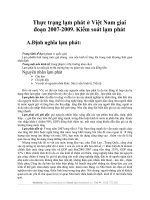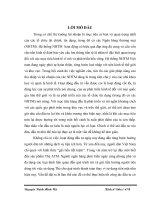IME march 2007 workshop nebraska
Bạn đang xem bản rút gọn của tài liệu. Xem và tải ngay bản đầy đủ của tài liệu tại đây (644.78 KB, 36 trang )
The Mathematical Education of K-8 Teachers
at the University of Nebraska-Lincoln,
a Mathematics – Mathematics Education
Partnership
Jim Lewis and Cheryl Olsen
University of Nebraska-Lincoln
The Mathematics Semester
for future elementary school teachers
and
Math in the Middle Institute Partnership a
professional development program for
middle level teachers
The Mathematics Semester
Math Matters, an NSF-funded CCLI grant began in 2000,
and became The Mathematics Semester in Fall 2003
Vision
• Create a mathematician – mathematics educator
partnership with the goal of improving the mathematics
education of future elementary school teachers
• Link field experiences, pedagogy and mathematics
instruction
• Create math classes that are both accessible and useful
for future elementary school teachers
The Mathematics Semester
(For all Elementary Education majors starting Fall 2003)
•
•
•
•
MATH
Math 300 – Number and Number Sense (3 cr)
PEDAGOGY
TEAC 308 – Math Methods (3 cr)
TEAC 351 – The Learner Centered Classroom (2 cr)
FIELD EXPERIENCE
TEAC 297b – Professional Practicum Exper. (2 cr)
(a field experience in a local elementary school)
– Students are in an elementary school on Mondays and
Wednesdays (four hours/day)
– Math 300 & TEAC 308 are taught as a 3-hour block on Tuesday
and Thursday
– TEAC 351 is taught on site at a participating elementary school
A look inside The Mathematics Semester
• Curriculum materials
• Homework to develop mathematical habits of
mind
• Professional writings
• The curriculum project
• Learning and Teaching Project
• Activities at the elementary school
– Teaching a Math Lesson
– Child Study
Curriculum Materials
• Sowder, J. et al. (2007). Reasoning about Numbers and
Quantities. W. H. Freeman. (prepublication copy)
• Schifter, D., Bastable, V., & Russell, S.J. (1999).
Number and operations, part I: Building a system of
tens. Parsippany, NJ: Dale Seymour.
• Reys, Lindquist, Lambdin, Smith, & Suydam (2007).
Helping Children Learn Mathematics. John Wiley &
Sons.
• Lampert, M. (2001). Teaching problems and the
problems of teaching. New Haven, CT: Yale University.
A problem to get started
Making change
What is the fewest number of coins that it will take to
make 43 cents if you have available pennies, nickels,
dimes, and quarters? After you have solved this
problem, provide an explanation that proves that your
answer is correct?
How does the answer (and the justification) change if
you only have pennies, dimes, and quarters available?
Note: We first encountered this problem in a conversation with
Deborah Ball.
A Typical Weekly Homework
All Shook Up
Five couples met one evening at a local restaurant for
dinner. Alicia and her husband Samuel arrived first. As
the others came in some shook hands and some did not.
No one shook hands with his or her own spouse. At the
end Alicia noted that each of the other 9 people had
shaken the hands of a different number of people. That
is, one shook no one's hand, one shook one, one shook
two, etc., all the way to one who shook hands with 8 of
the people. How many people did Samuel shake hands
with?
Note: This problem is a slightly modified version of Exercise #14,
page 32, in The Heart of Mathematics, by Burger and Starbird, Key
Curriculum Publishing, 2005.
Professional Writings
Dear Math Professors,
We are 1st and 2nd graders in Wheeler Central Public School in
Erickson, Nebraska. We love to work with big numbers and have
been doing it all year! Every time we read something with a big
number in it we try to write it. Then our teacher explains how to write
it. We are getting pretty good at writing millions and billions!
We have a problem that we need your help with. We were reading
amazing ‘Super Mom’ facts in a Kid City magazine. It told how many
eggs some animals could lay. We came across a number that we
don’t know. It had a 2 and then a 1 followed by 105 zeros!! We
wrote the number out and it stretches clear across our classroom!
We know about a googol. We looked it up in the dictionary. A googol
has 100 zeros. Then what do you call a number if it has more than
100 zeros? Is there a name for it?
Another problem is that we learned about using commas in large
numbers. In the magazine article they used no commas when
writing this large number. That confused us. Also, if you write a
‘googol’ with 100 zeros, how do you put the commas in? It doesn’t
divide evenly into groups of 3 zeros. There will be one left over.
We appreciate any help you can give us solving this “big” problem.
Thank you for your time.
Sincerely,
Mrs. Thompson’s 1st & 2nd graders
Megan Kansier, Mark Rogers
Marcus Witt, Ashley Johnson
clipping from Kid City magazine
Apple Of My Eye
The tiny female apple aphid is a champ
as an egg-layer. This insect can lay as
many as 21000000000000
00000000000000000000000
00000000000000000000000
00000000000000000000000
00000000000000000000000
0000 eggs in 10 months.
M2 Innovations
Professional Writings
What do Math Teachers Need to Be?
Read “What do Math Teachers Need to Be?”* by Herb Clemens, a
mathematics professor at The Ohio State University. Where does
your own practice of teaching mathematics stand in relationship to
what Clemens says mathematics teachers need to be: unafraid,
reverent, humble, opportunistic, versatile, and in control of their
math. If Clemens came to your classroom and watched you teach
math, how would he answer his question: Can this teacher teach it
[math] with conviction, and with some feeling for its essence?
Explain.
* Published in 1991 in Teaching academic subjects to diverse
learners (pp. 84-96).
Curriculum Project
The goal is to investigate a new mathematical area of the
elementary curriculum and consider what teachers need to know as
well as what children need to learn the topic in the deep and
meaningful ways suggested by the NCTM Standards (2000).
1) Pick a topic: data analysis and probability, geometry, reasoning and
proof, or algebra.
2) Read, analyze, and synthesize the mathematical topic in the NCTM
Standards.
3) Analyze and synthesize the topic in a set of reform curriculum
materials (Everyday Math, Trail Blazers, Investigations, local
curriculum).
4) What do teachers need to know to teach this?
5) Create 5 math problems that would help teachers learn. Create 5
math problems that would help children learn.
Learning and Teaching Project
Area and Perimeter
The task began with a homework problem. It is taken
from Reconceptualizing Mathematics: Courseware for
Elementary and Middle School Teachers, Center for
Research in Mathematics and Science Education, 1998.
Is there a relationship between the area and the
perimeter of a polygonal shape made with congruent
square regions? (For fixed area, find the minimum and
maximum perimeter. For fixed perimeter, find the
minimum and maximum area.) Squares must be joined
complete-side to complete-side. The outside “boundary”
should be a polygon. In particular, this would not permit
a shape with a “hole” in the middle.
A couple of weeks later we told our students:
We want to revisit the “Area and Perimeter” problem. This is
to be the basis for a mathematics lesson that you will
videotape yourself teaching to one elementary school student.
How can you present this task to the student you will teach?
How can you set the stage for the student to understand the
problem? How far can the student go in exploring this
problem? Remember that you want your student to discover
as much as possible for himself (or herself). But there may be
some critical points where you need to guide the student over
an intellectual “bump” so that he (she) can move on to the
next part of the problem.
Finally, produce a report analyzing the mathematics and your
teaching experience.
Activities at the elementary school
Math Lesson. You will teach a math lesson that
connects to the curriculum in the classroom in which you
are working. You should make use of the textbook and
other resources from your cooperating teacher and what
you are learning and reading in the Mathematics
Semester.
Child Study. This assignment will give you some
experience watching, listening to, probing, and
assessing one child’s understanding of several math
problems focused on a particular area of mathematics.
You will write a report of your interview and suggest
instruction for the child based on the information you
gathered in the interview session.
Math in the Middle
Institute Partnership
Principal Investigators
Jim Lewis, Department of Mathematics
Ruth Heaton, Department of Teaching,
Learning & Teacher Education
Barb Jacobson, Lincoln Public Schools
Tom McGowan, Chair, Department of
Teaching, Learning & Teacher Education
(Funding began August 1, 2004)
M2 Goal
Invest in high-quality teachers
* To improve K-12 student achievement in
mathematics and to significantly reduce achievement
gaps in the mathematical performance of diverse student
populations.
M2 Partnership Vision
• Create and sustain a University, Educational Service
Unit (ESU), Local School District partnership
• Educate and support teams of outstanding middle
level (Grades 5 – 8) mathematics teachers who will
become intellectual leaders in their schools, districts,
and ESUs.
• Provide evidence-based contributions to research
on learning, teaching, and professional
development.
• Place a special focus on rural teachers, schools,
and districts.
M2 Partnerships
People and Organizations
• All 14 rural Educational
Service Units plus LPS
• 65 Local School Districts
• 91 Schools
• 130 Teachers (4th cohort
will begin summer 2007)
– 29 teachers earned their
Masters Degree 2006
M2 Major Components
• The M2 Institute, a multi-year (25-month) institute that
offers participants a coherent program of study to
deepen their mathematical and pedagogical knowledge
for teaching and to develop their leadership skills;
• Mathematics learning teams, led by M2 teachers and
supported by school administrators and university
faculty, which develop collegiality, help teachers align
their teaching with state standards, and assist teachers
in examining their instructional and assessment
practices; and
• A research initiative that will transform the M2 Institute
and the M2 mathematics learning teams into laboratories
for educational improvement and innovation.
Math in the Middle Institute
Partnership
M2 courses focus on these objectives:
• enhancing mathematical knowledge
• enabling teachers to transfer mathematics
they have learned into their classrooms
• leadership development and
• action research
Math in the Middle
Institute Design
Summer
Fall
Spring
Yr 1
Wk1
Wk2&3
M800T Teac800 & M802T
M804T
M805T
Yr 2
M806T Teac801 & Stat892
Teac888 M807T
Yr 3
M808T Teac889/M809T
and the Masters Exam
- A 25-month, 36-hour graduate program.
M2 Summer Institute
•
•
•
•
•
Combination of 1 week and 2 week classes.
Teachers are in class from 8:00 a.m. - 5:00 p.m.
32-35 teachers – 5 instructors in class at one time.
Substantial homework each night.
Substantial End-of-Course problem set
– Purpose – long term retention of knowledge gained.
– Presentation of solutions/celebration of success at start of next
class.
M2 Academic Year Courses
• Two-day (8:00 – 5:00) on-campus class session.
• Course completed as an on-line, distance
education course using Blackboard and Breeze.
–
–
–
–
–
Major problem sets
Professional Writings
Learning and Teaching Projects
End-of-Course problem set
Substantial support available for teachers








